On the history of Pöide St Mary’s Church and congregation
In 1227, after surrender to the combined forces of the crusaders led by the Bishop of Riga, the Master of the Livonian Brothers of The Sword and a Papal vice-legate, the islanders of Saaremaa formally accepted Christianity. Saaremaa (Ösel) was divided between the Bishop of Riga, the Order of the Brothers of the Sword (Fratres militiæ Christi Livoniae, later the Teutonic Order) and the City of Riga, the region of Pöide becoming the administrative centre of the territory controlled by the Order. Here, in the vicinity of an ancient hillfort, the new rulers built a church and a castle.

View of the church from Pöide stronghold. Photo by Veiko Vihuri
Is there a link between the place name Pöide and the Order Castle?
År 1223 nämns en plats som heter Horele (jfr Ardla bynamn, tidigare Hordele). Man tror att ön Muhu och området Pöide före erövringen tillhörde samma forntida härad. Pöides platsnamn (i form av Poide) nämndes först 1254. Historikern Enn Tarvel baserar namnet på ordet pöös: pööse (flagga, sten) och förbinder det med den skifferbyggda tornfästningen, som är nämnt i senare källor:
”Det finns inget som utesluter antagandet att tornet i Pöide började byggas om strax efter återövringen 1241. I så fall skulle det finnas ett dussin år kvar att bygga tornfästningen, födelsen av namnet och dess förstärkning. ”
I slutet av 1200-talet uppstod en konflikt mellan biskopen av Saaremaa och de tyska riddarna. Det klagades över att riddarna hade fängslat 80 öbor som beordrades att komma beväpnade. Biskopen i Saaremaa hade uppmanat ordningens domare att sluta plåga de nyligen döpta. Enligt en källa skulle orden ha fört människor från Kurland till Saaremaa “som utan någon utbildning och dop av tro” hade beordrats att förstöra ett torn från en plats som heter Pöide. Det finns ingen exakt information om detta, men de nämnda händelserna äger rum under inbördeskriget. Riddarna tvingades använda hedniska kurlänningar för att stärka sina positioner i fästningen i Pöide.In 1233, an area named Horele (cf. the name of the present-day Ardla, formerly Hordele village). It is believed that before occupation, Muhu Island and Pöide region had formed one ancient pre-historic parish. The place name Pöide (Poide) occurred for the first time as late as in 1254. The historian Enn Tarvel has derived the place name from the word ’põõs: poose’ meaning ’(lime) stone; rock’ referring to the lime stone castle mentioned in later chronicles: „We have grounds to assume that building of the Pöide tower could start in 1241, right after the islanders had been reconquered. In that case, there must have been about a dozen years for erection of the tower castle, for finding a name for the place and for getting the name established.”
At the very end of the 13th century, a conflict arose between the Bishop of Saaremaa (Ösel) and the Teutonic Order. Afterwards accusations were made against the Order of imprisoning in Pöide 80 islanders who had been ordered to appear in the castle with their weapons. The Bishop of Saaremaa is said to have admonished the Head of the Order not to penalise the newly baptised. Also, a story circulated claiming that the Teutonic Order had even used unbaptised heathens taken from Courland to Saaremaa to be able to seize a tower in a place called Pöide. It is not quite clear what exactly happened, but those events may have occurred during the civil war, indicating that the Order was forced to use extreme measures to secure its position in Pöide.
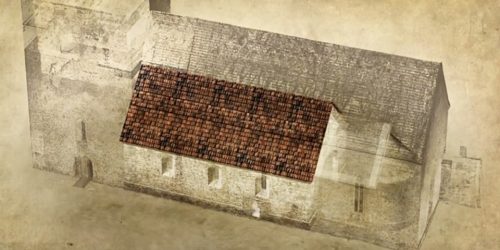
Different construction stages of Pöide church. Screen capture of the documentary „Pöide, vaikiv tunnistaja“ („Pöide, a silent witness“)
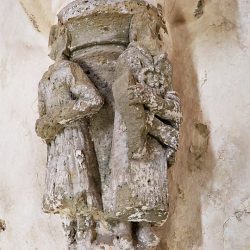
Stone carvings of Pöide Church depicting Estonians. A man on the left, a woman with a brooch and a drinking horn, on the right. Photo by Veiko Vihuri
The Peasants’ Revolt of 1343
In the 16th century, relying on the Livonian Rhymed Chronicle, Johannes Renner, the Order official, wrote that in 1343, a day before St. James’s day the islanders had slaughtered all Germans, young or old and drowned the priests in the sea, and then they had gathered at Pöide Order Castle standing there in siege for eight days. Realising that they were not strong enough to withstand the siege of the local peasants, the bailiff of the Order had attempted at making peace with the islanders and opened the gates to the stronghold. But the treacherous peasants did not keep their promise, they started hurling stones at the enemy killing the bailiff, five other Order members, numerous servants and everybody else who was in the castle.
According to Chronica Livoniae
by Hermann Von Wartberge, the castle of Pöide was sieged and after its peaceful surrender, the newly baptised peasants killed Arnold, the bailiff, priest Johannes and many other Order members and servants with stones thrown at them. Some clergymen of the parish and secular priests were drowned in the sea, many vassals and Christians – both men and women – were killed.
When the revolt had been suppressed, the islanders were made to build a new fortress for the Order, Soneburg, at Maasi. Pöide castle was destroyed and its remains are buried deep under soil.
The Lutheran congregation of Pöide
Unfortunately, very little is known about medieval church activities and life in Pöide – just the names of a few priests who served there. One of them was Bertrammus, the Order priest serving in Pöide at the turn of the 13th-14th centuries. There is also a written record from the year 1554 of a fire at the parsonage and in the church tower.
Pöide Church became the home of a Lutheran congregation in 1562 when Frederick II of Denmark enacted Danish Lutheran church order in Saaremaa (Öesel), or even somewhat earlier.
Reformation brought along gradual changes in interior planning. In Pöide church, side altars characteristic of Catholicism, but not used in Lutheran tradition remained there for more than a century until in mid-1670s they were removed and replaced by pews. Also, the baptismal font was relocated and placed in front of the chancel.
In 1613, two noblemen of Saaremaa (Öesel) were put to death in Copenhagen for a crime committed against His Majesty the King (they had cooperated with Swedes in Kalmar War). One of the executed noblemen was the owner of Tumala (Thomel) manor Heinrich Schulmann whose tombstone can presumably be found in the chancel of Pöide church.
In 1675, the parish of Jaani (Johannis) was separated from Pöide parish and St John (Jaani) congregation was formed. In this area, a leper asylum had been founded in the Teutonic Order period and it was the duty of the pastor of Pöide parish to serve sick people with the word of God.
The plague epidemic of the year 1710 had devastating results: very many people died, leaving farmsteads empty. The then pastor of Pöide Church, Balthasar Johann Rubusch was one of the few clergymen of Saaremaa who survived the epidemic. He was the rural dean of Saaremaa between 1711/1712 and 1719.
In the 18th century, the number of congregation members was increasing. In 1782, the congregation of Pöide consisted of 3700 persons, 1800 of them had taken Communion. At that time, the congregation of Pöide was one of the biggest on the island, together with those of Kaarma, Karja and Kihelkonna.
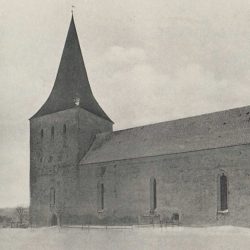
Pöide church in 1896. Photo: from book „Alt-Livland…“ by R. Guleke
Conversion movement and its consequences
The religious conversion movement taking place in 1846-1848 shook the island of Saaremaa to a great deal. In Pöide parish, nearly 5000 people (68% of the local peasants) converted from Lutheranism to Russian Orthodoxy. The pastor complained that there was a rumour spreading around urging peasants to convert, or otherwise they would be destined to remain forever in serfdom under Germans.
Considering the great number of converts, the Governor General was petitioned for putting Pöide Church at the disposal of the Orthodox. Despite the reports telling that after being left without a pastor, the number of people attending Lutheran services had shrunk, varying between two and ten, Pöide Church remained a Lutheran church. In 1873, an Orthodox church was completed and consecrated at Tornimäe, not far from Pöide.
Since 1873, the same priest attended to both Pöide and Jaani congregations.
In 1843, a lightning struck the church spire starting a fire. In 1852, due to the construction of the organ balcony, a wall was built between the tower bay and the rest of the church.
Baron Karl Nikolai von Nolcken, pastor of Pöide parish between 1867 and 1901, became a devoted leader of congregation activities. He placed great emphasis on pastoral care, including confession, and on choral singing of hymns. Being interested in the Estonian language, in 1873, he compiled two Estonian alphabet booklets (primers) and published Martin Luther’s Catechisms in two volumes (1876/78). Baron von Nolcken introduced Estonian national epic Kalevipoeg to Germans in his work „Der Kalevipoeg, nach seinem epischen Werthe betrachtet“.
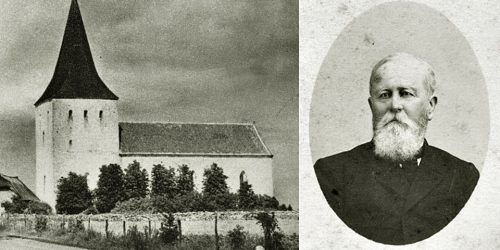
View of Pöide Church. To the right pastor baron von Nolcken.
The first Estonian pastor serving Pöide congregation was Karl Sitzka (1902-1912).
In 1908, Pöide congregation had 1241 members, including 35 Germans. The church had 320 seats. In 1904, a large-scale renovation was carried out.
The devasting 1940s
In the autumn of 1939, the last Baltic-German pastor Kurt-Rudolf Schulz left for Germany. On August 6, 1940, the very day that Estonia became a member state of the Soviet Union, as an omen of a difficult time ahead, a lightning struck again in the spire of the church putting it in fire. Recalls Jaan Ratassepp, the son of the then sexton Eduard Ratassepp: „I saw the lightning struck the globe at the top of the spire. After a bright flash tongues of fire flung out symmetrically in all four directions.“ The fire developed so fast that within a quarter of an hour the globe with the weather vane attached to it fell down. According to the inscription on the weather vane, it dated from the year 1734. The fire kept blazing for four hours until it died down. Firefighters were not able to bring the fire under control as the spire was tall and the water jets from the hoses of the fire engine could not reach the flames.
In the middle of the 1940s the soldiers of the Soviet army almost completely destroyed the interior elements and decorations of the church. The only artefact that has survived is the sculpture of Saint Peter the Apostle (1635) supporting the pulpit, deposited now in Saaremaa Museum. In 1945, the church building was given a completely different function: it became a hay storage guarded by an armed squad. People told that the horses carrying hay balked and were reluctant to enter the church.
In 1948, the congregation was closed and the church building was left in disrepair.
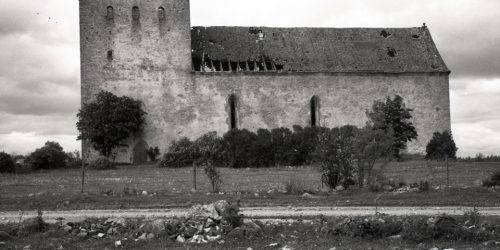
Pöide Church in 1955. Photo by T. Linna, Saaremaa Museum
Rebirth
During the period of the reawakening of Estonia as an independent nation in the late 1980s began the restoration of the Pöide congregation. On December 12, 1990 the Consistory of the Estonian Evangelical Lutheran Church officially registered Pöide congregation as a legal heir of the former congregations with all rights and obligations. In the beginning the services were held in the parsonage hall.
In 1994, nearly 500 people attended the nationwide summer camp of young Christians that took place near Pöide church.
On May 2, 1999, Archbishop Jaan Kiivit consecrated the renovated chancel of Pöide church.
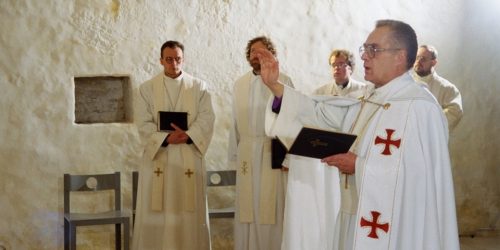
Archbishop Jaan Kiivit is consecrating the renovated chancel. In the background: Anti Toplaan, Gustav Kutsar, Illimar Toomet, and Veiko Vihuri.
In summer, Pöide church is open for visitors and people interested in history. Pöide church has hosted superb sacred music concerts given by Estonian musicians (Hortus Musicus, Vox Clamantis et al).
Compiled by Veiko Vihuri
THE CLERGYMEN OF PÖIDE
Before the year 1560
Bertrammus, 1306
Johannes, d. 1343
Hermann Ronneberg, 1507
Urbanus Milde, 1557
Lutheran pastors
Timan Brackel (Püha), 1574–1576
Jürgen (Georg) von Alen, 2nd half of the 16th century
Hermann Rodenwaldt, 1594, 1599
Hermannus Arendess, before 1639
Luderus Bunekenius, 1639, 1661
Johannes Bünkenius, 1674, 1677, 1680, d. 1689
Balthasar Joh. Rubusch, 1692–1719
Joh. Georg Sorger, 1720–1731
Joh. Ludwig Dittmar, 1732–1762
Johann Heinrich Jürgens, 1763–1782
Andreas Agthe, 1782–1817
Wilhelm Andreas Fürchtegott Agthe, 1817–1841 (adjunct 1813)
Paul Eduard Hirsch, 1842–1846
Konstantin Konrad Anders, 1847–1859
Oskar Carlblom, 1860–1865
Baron Karl Nikolai von Nolcken, 1867–1901
Karl Sitzka, 1902–1912
Herbert Konstantin Johannes Lieberg, 1914–1919
Adalgoth Julius von Seck, 1922–1927
Kurt-Rudolf Schultz, 1927–1939
Johannes Paesalu, 1939–1941 (elected vicar in 1940, dismissed in 1945)
Robert Kannukene, 1942–1944 (temporary vicar)
Ernst Puusepp, 1944
Alfred Tammiko (Valjala), custodian pastor 1946–1949
The congregation was dismissed in 1948
Clergy since restoration of the congregation in 1990
Custodian pastors:
Gustav Kutsar (Valjala), until 1994
Illimar Toomet (Muhu), 1994–2000
Gustav Kutsar (Valjala), 2000 (April – October)
Veiko Vihuri (Karja), 2000–2007
Urmo Saks (Muhu), 2007–2010
Veiko Vihuri (Karja), 2010 –
Deacons:
Veiko Vihuri, 1992 (January–November)
Hannes Nelis, 1992 (November–December)
Peeter Vigel, 2001–2003
Heinar Roosimägi, 2003–2005
Urmo Saks, 2005–2007
(vicar deacon of the deanery),
2015–2017 (deacon of Pöide congregation)
